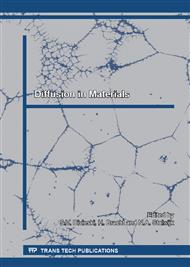p.79
p.85
p.91
p.101
p.106
p.112
p.120
p.127
p.130
Effect of Purity on Dislocation-Induced Relaxations in Molybdenum Single Crystals
Abstract:
Dislocation-induced relaxations in different molybdenum single crystals were investigated by means of low-frequency internal friction measurements in the temperature range of 20–600 K. The results indicated that the appearance of the dislocation-induced relaxations strongly depends on the purity of the molybdenum, although the intrinsic dislocation relaxations appeared at about 100 K and 450 K in the high-purity molybdenum. The molybdenum containing a small amount of carbon did not exhibit the intrinsic dislocation relaxations but rather revealed a modulus increase due to the dislocation pinning caused by the dissolved carbon. When the molybdenum containing a small amount of carbon was annealed up to 700 K, a new relaxation peak appeared at about 450 K. The activation process for this relaxation indicated that it could be attributed to the relaxation due to a carbon-dislocation interaction. In addition, it was shown that the dislocation-induced relaxations in medium-purity molybdenum were small, which was attributed to the residual substitutional impurities in the molybdenum.
Info:
Periodical:
Pages:
106-111
Citation:
Online since:
May 2015
Authors:
Keywords:
Price:
Сopyright:
© 2015 Trans Tech Publications Ltd. All Rights Reserved
Share:
Citation:


